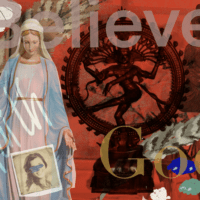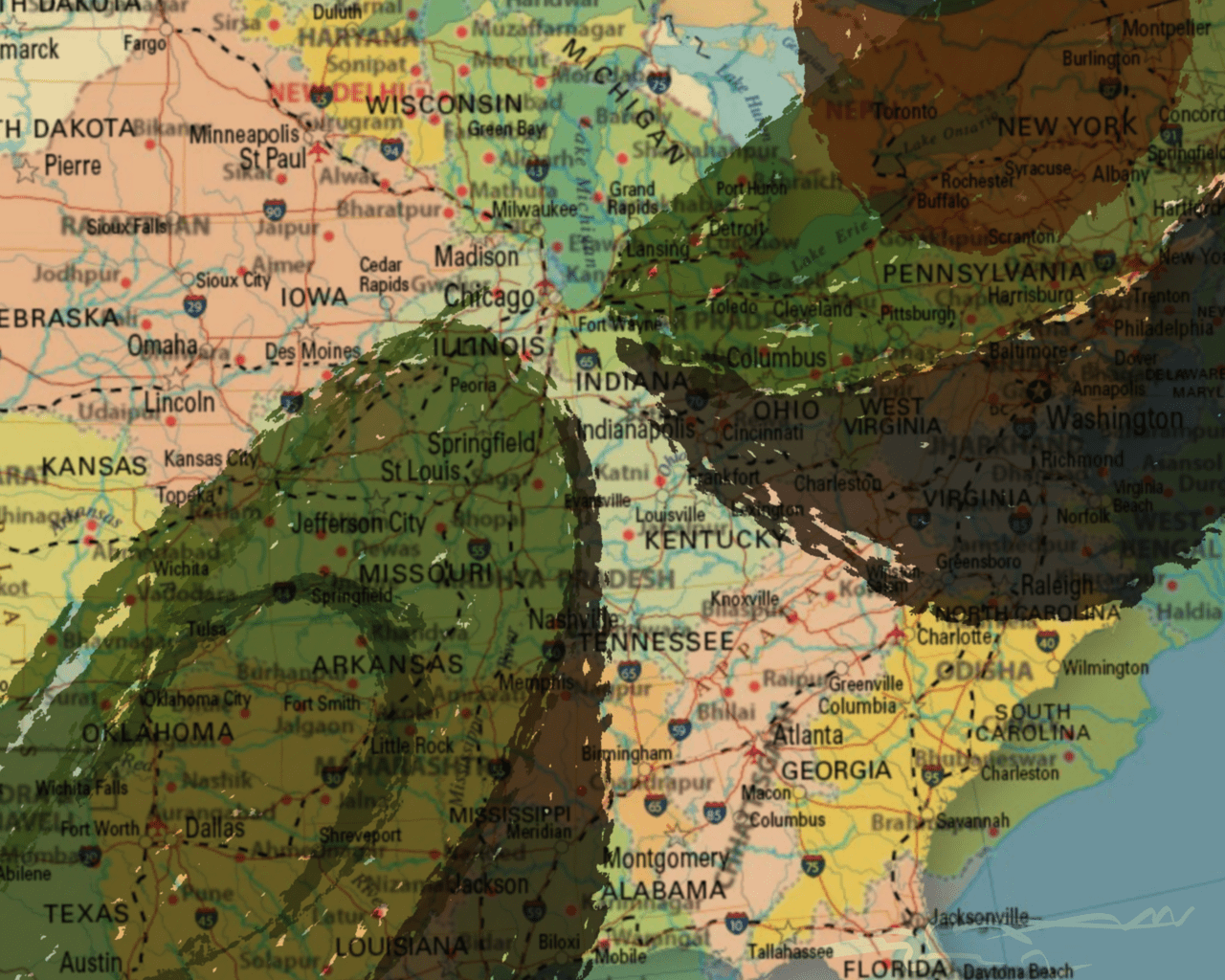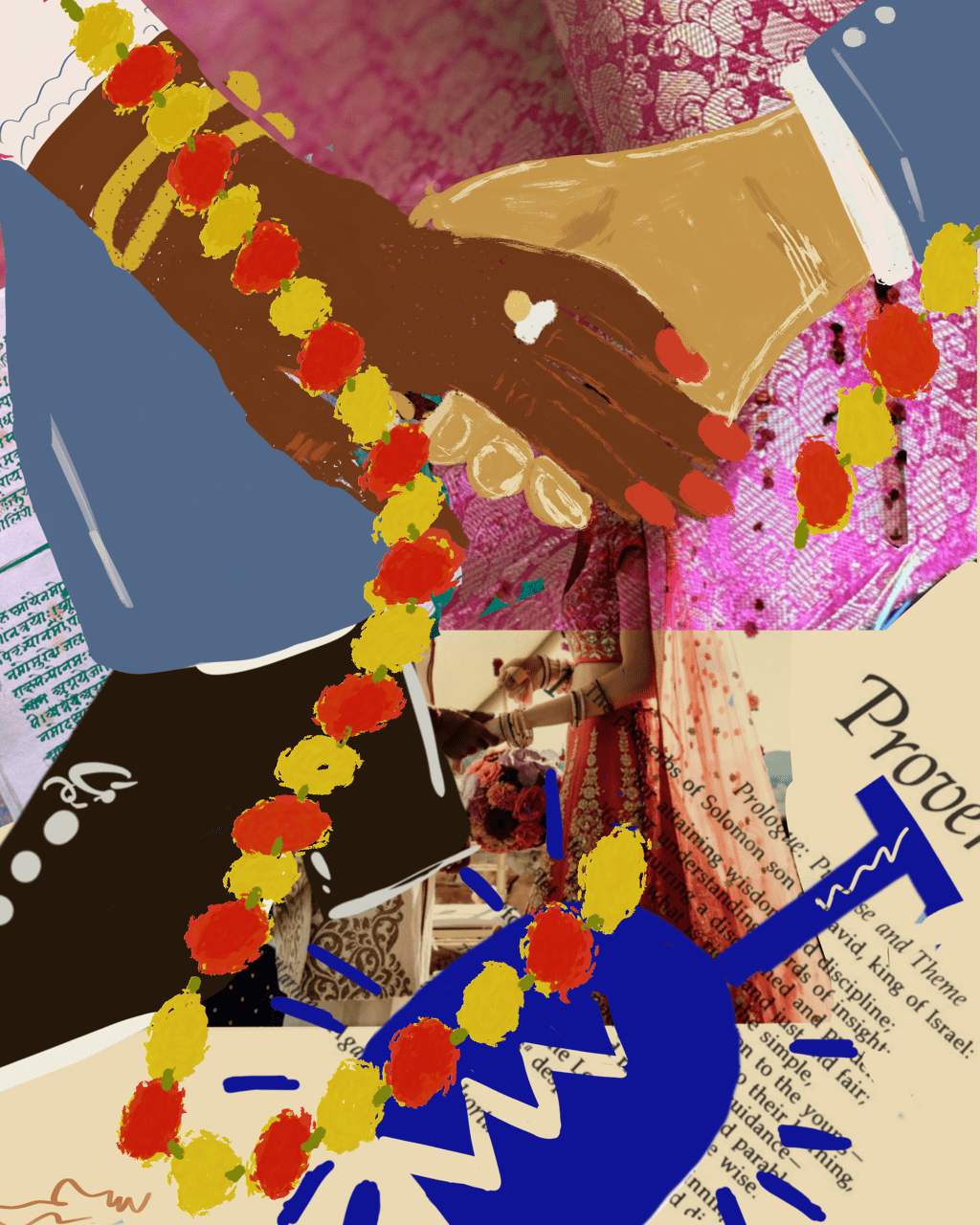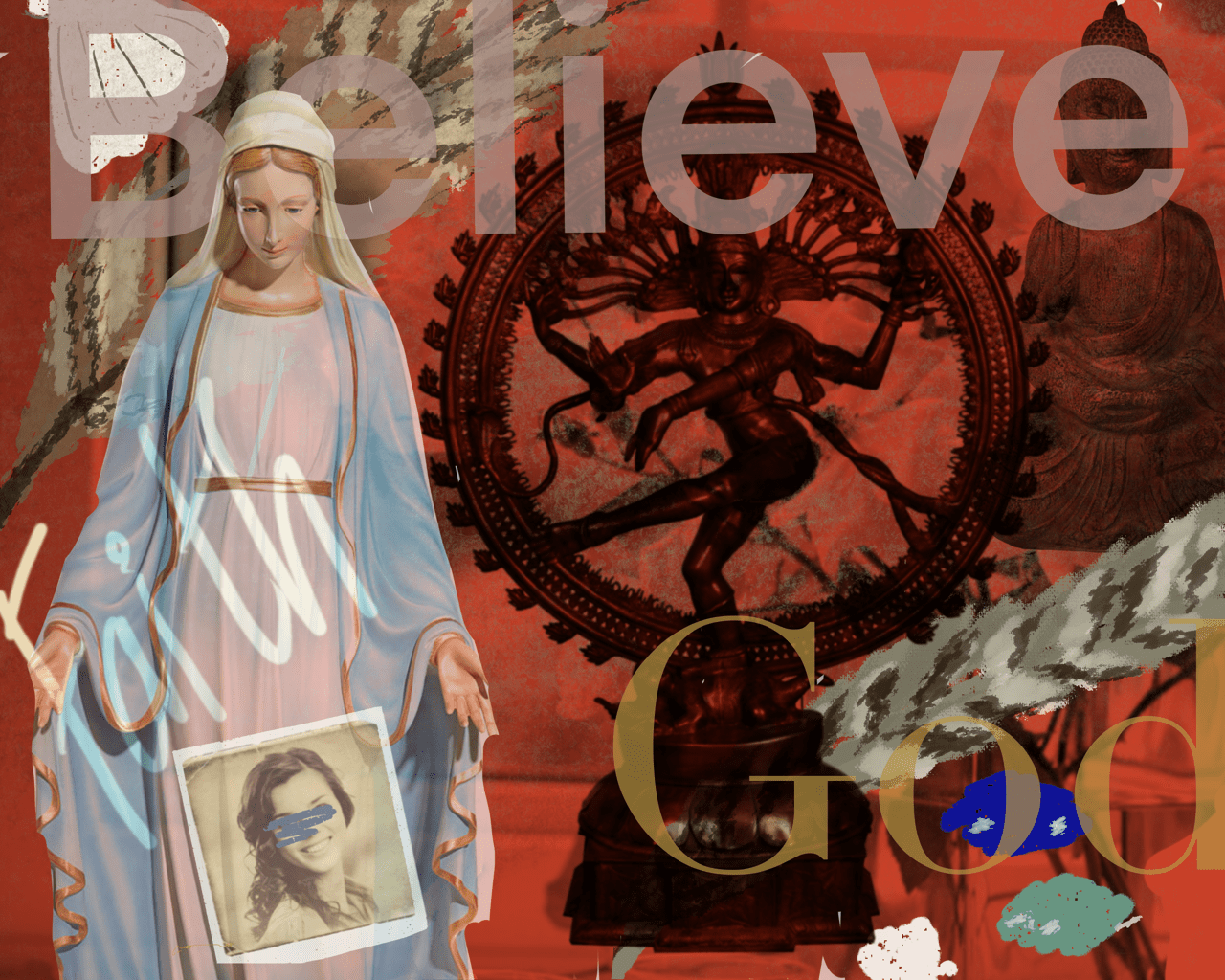1.
Before these last few years, my Catholic Protestant heritage as an Indian American woman married to a Russian Jewish man with a biracial son was mostly a good thing. But Trump’s election and the climate in this country afterward upended the basket of identities I carried around so casually; now, a nagging, headless specter seemed to follow me everywhere, whispering choose.
In his memoir, Brown, Richard Rodriguez describes the paradox (to some) of being gay, Catholic and Hispanic American in fruitarian terms: “When you slice an avocado, the pit has to go with one side or the other, doesn’t it?” My answer to Rodriguez is a qualified yes. An undisturbed avocado is a peaceful fruit, carrying its heart in its center, balanced. The choice of which side the pit goes, is only on the occasion of the avocado’s wholeness being severed and exposed.
Living in Los Angeles, I’ve been mistaken for Latina, Persian and Israeli at different times and it’s never not flattering. When someone talks to me on the street in Spanish without any introduction, no matter what they are saying, it’s as if I hear the first word as “hermana.” Or my husband will say, “She grew up on Long Island; she’s an honorary Jew.” I love this expansive sense of belonging; I never once considered whether it made me more vulnerable.
Now, my son wants to set up a sidewalk stall to sell homemade comic books, but we’ve read about ICE raids targeting any street vendor who doesn’t look white. We ask ourselves, Are Jews considered white? and when a swastika signs show up on driveways in a progressive neighborhood east of us, I add in my mind, …and by whom? On a pit stop off the I-5 in a rural town between Los Angeles and San Francisco, I worry about standing out. The main attraction is a shopping center remade to look like a street from the Wild West with stores full of Americana. We’ve been here before, but in just a single visit it’s gone from being funny and even a little charming to terrifying, a white West that stands for extinction of the other. This sad reclassification of every encounter is new to me, even if the threat is not.
For the first time in more than thirty years of living in this country I wonder if my religion at birth offers a kind of social currency, a protection that comes from aligning with the majority.
“It didn’t help Sandra Bland,” a friend reminds me. Bland wrote about racial injustice and her Christian faith on her blog #SandySpeaks. Her faith gave her hope. When the officer implicated in her murder was identified, some who knew him expressed disbelief. “He was a good Christian man.” But their shared Christianity didn’t protect her.
Choose, whispers the specter.
2.
My ancestors didn’t get to choose.
My mother’s side of the family traces its conversion to Catholicism under the Portuguese in the 1700s, part of a breakaway community that fled the Portuguese occupation in Goa and settled in a nearby coastal town of Mangalore. Mangaloreans absorbed Portuguese culture; they made homemade wine and let their children drink it with dinner. Unlike other Indians, they ate pork and had affectionate names for the fat, gil gil. They kissed on both cheeks when greeting and said goodbye, never namaste. They married within their small community. They went to specific schools, mostly Jesuit, and buried their dead in specific cemeteries, separate from the Protestants.
The logic of the hybrid is combined yet distinct. Even if belief systems crossed lines, blood didn’t.
Two years ago, I took 23andMe’s genetic test. I am 99.5% South Asian. I was surprised I had no European blood at all despite our conversion to Christianity nearly three hundred years ago. When I told my cousin this he said, “Your genes are pure; there’s no humiliation in that. It means nothing bad happened. Nothing was forced.”
But was it a matter of choice? My relatives describe our family’s conversion to Christianity as voluntary or at least negotiated, but this is hard to reconcile against the historic facts of the Portuguese inquisition during which people who refused to convert were tortured and hanged, Hindu temples destroyed, and books in many Indian languages burned. My father’s family converted to Protestantism in the mid-1800s under the British, who might have used less brutal tactics but still dangled “favored status” carrots like jobs, education, and the ability to own property and prosper from trade as rewards.
By the time the religious identity pinball works its way through the maze to land in my particular Christian bucket, it traces an unusual path. Am I a Christian is less a matter of faith than the set up to a more primary question: was I forced to be one?
Choose, the specter points in opposite directions.
3.
Identifying as Christian today, I sometimes feel separated, even alienated, from other progressives and people of color.
Sahil Chinoy published an interactive quiz in the New York Times in 2019 that tries to predict whether you’re a Republican or Democrat. It starts with the question: “Are you Black, Hispanic or Asian?” I answered yes. Then it asks, “Are you Black?” I answered no. The next question was, “Are you Protestant?” I hesitated, but chose yes. “Is your family income less than 40k a year?” No. In just those four questions, I was “11x more likely to be Republican.” Identifying as a Protestant catapulted me out of my ethnicity and income buckets. Had I simply answered no to being Christian, I would have been twenty times more likely to be a Democrat.
I was bewildered in a similar way when I did an exercise with a group during a leadership retreat and ranked “liberty” over “equality” as a fundamental value. That decision grouped me with two conservative Christian white men in the military from rural America while all the women and people of color in the room—basically everyone who looked like me—ended up in the group that ranked “equality” as a more important value than “liberty.”
One of the two men I was grouped with was a member of an elite “special operations” squadron in the Air Force. He ranked liberty so high, he joked he would have marked a spot off the chart if he could have; there was no value more important to him. At the cocktail party the first night of the retreat, I explained how I’d felt safe growing up in India as part of a religious minority, but it was changing. “Look at what happened in Sri Lanka last week. Terrorists bombed churches; people died waiting on line at an Easter Sunday buffet.” The group got quiet. “Blessed are those who persecute you in my name,” the Air Force member said as he joined the conversation like an oracle. “That’s Matthew 5:44 right?” he asked. In circles I’m used to, this would have been a bizarre intrusion, but I found myself nodding yes. I was connecting with a stranger through a part of my identity I didn’t normally own, and it felt comforting but also confusing, like seeing a familiar childhood toy out of context.
On the last day of our retreat, our group had to vote on a name for itself. Someone proposed “Amazing Grace” to commemorate the magical night we sang the song around a fire. It was all but decided when I got a text the morning of the vote from a friend in the group who was Indian and Hindu. He was not sure a Judeo-Christian hymn was the appropriate choice for something meant to represent all of us. I felt ashamed for not thinking of this first. I felt more ashamed for loving the song so much, and for feeling disappointed we’d have to drop it as our anthem. I’m pretty sure my friend knew I was Christian, but in that moment, in the space of a private text, I was just Indian.
Rodriguez redefines “brown” not as an identity but that which resists a singular identity. “The tension I have come to depend upon. That is what I mean by brown. The answer is I cannot reconcile.”
I cannot reconcile, either. The specter shifts in unrest; is because I cannot or will not choose?
4.
Christian prayer was how I first connected with my mother. When I was two years old, she died unexpectedly from a complication of what would have been a safe surgery today. No matter how hard I try, I can’t access any conscious memory of her. After she passed away, my grandparents and father moved in together to take care of me. One of our rituals was to say the rosary at night in the living room.
Right before I want to sleep in my bed, I recited a coda just for me, “Dear God, make me a good girl. Take my Amma to heaven soon. Amen.” I don’t know why I thought she was stranded in purgatory and not in heaven yet. Maybe no one had the heart to update the prayer I was so used to saying as a toddler, even though I was still saying it at the age of nine. Maybe I wasn’t ready to let her go; if she went to heaven, she would really be gone. Whatever the reason, those words carved a space for her within me; they were attached to the truth of her. The proof of her.
My grandmother, who transformed quietly and seamlessly into my mother, had a bottle of holy water from Lourdes, a souvenir from her trip to France with a group of Indian Catholic women in 1970. It was grayish-white, with lemon-yellow straps like stirrups and a matching yellow cap that twisted off and served as a small cup to drink from. When I was sick, she fed me capfuls of the water. She’d lost a daughter, and now the granddaughter she was left in charge of would get every last potion and spell thrown at her. Never again.
My uncle says the bottle from Lourdes wasn’t white, that it was blue and much smaller. But I’m the one who drank from it, the one who believed in its power.
To choose might mean giving up on miracles.
5.
My mother wasn’t just any Catholic. According to her best friend, Pratima, my mother was profoundly influenced by the work of Elizabeth Reid, the Australian founder of a female-led missionary movement called the Grail. In her memoir, I Belong Where I’m Needed, Reid recounts the words the time five hundred women in one voice chanted, “We will know ourselves God’s messengers and ours the world to leaven and to win.”
My mother joined the Grail after graduate school but died just two years later, at the age of twenty-eight, before she had a chance to travel outside India to spread its teachings. Ever since I can remember, people talked about my mother’s intelligence, her faith, her single-minded dedication to service. I was a saint’s daughter.
Was I supposed to pick up where she left off? If so, I was dropping the ball badly.
At twenty-eight, I was hardly religious and couldn’t tell you what my mission was. I’d dropped out of a career in medicine and fled the East Coast not to save the world but to save myself. While I stayed in the field of healthcare, I was anything but single-minded, starting three companies and pursuing two other careers along the way.
Was not choosing a profession or specific faith a way of deferring hope that I could still live up to her legacy? Maybe I just hadn’t found the right path yet.
6.
When my son was born, my father wanted me to baptize him.
My father’s great-grandfather was a Hindu who, according to family lore, was kicked out of his community for converting to Christianity. Before the Church, birth records weren’t common. Being baptized was a way to document one’s existence. When he encouraged me to baptize my son, my father said, “No matter what happens, for all the progeny, they’ll be able to see his name written in the church records.” For someone whose first language isn’t English, my father uses the word “progeny” with a comical frequency.
While I still have the white satin and lace gown I was baptized in—which my mother held me in, which is so long and delicate it might have reached the floor from her arms—I couldn’t agree to have our son baptized. I would have to make a false statement during the script of the ceremony that I would raise my son as a Christian, and my husband and I couldn’t make that promise.
We had no problem with the most inclusive approach to all rituals as long as we didn’t have to choose. Our wedding ceremony was innocuous enough. We incorporated the Book of Proverbs, Hindu scripture, and lyrics by Chrissie Hynde of the Pretenders. We used a sari as a chuppah. My husband stepped on a glass and anointed my forehead with sindoor, a red powder that indicates a Hindu woman’s married status. We exchanged garlands as a Protestant interfaith minister presided.
Baptism would be a specific choice. So, we opted instead for the less committal “baby blessing” and for a Jewish naming ceremony, but not the traditional bris.
I’d broken a delicate strand connecting my ancestors to their descendants. How could I prevent a reverse erasure of our Christian heritage when I was complicit in it?
7.
Last year, my cousin in Bangalore told us about the “beef killings.” He explained, “They’re killing Christians who eat hamburgers, saying it disrespects Hindus. You have to be secretive even if you want to celebrate Christmas.” My uncle blamed Prime Minister Modi, who espouses Hindutva, a belief in Hindu supremacy, some followers of which believe ancient Indians launched spacecraft and performed plastic surgery hundreds of years before white people caught on.
From my cousin’s balcony, the lights of the Holy Ghost church next door are bright and huge and we can hear the priest singing through a loudspeaker with the congregation in response. I grew up just a couple of miles from here in a small apartment complex with four units. Though we were a Christian household and could walk to the Franciscan Catholic church, it was the call of the imam at the mosque that would dot the sounds of our mornings and rouse us from naps in the afternoon. The family in the flat above us were Zoroastrian, the family to their left were Buddhists from Mizoram, and our landlords were Muslim; when my father and I went caroling at Christmas, we were welcomed by them all. I lived my first years in India as a religious minority, and even if it was because of our particular neighborhood in our particular city, my childhood memory preserves this experience as a harmonious one. When I moved to America at the age of nine, my religious minority status was replaced by a racial minority status but my expectations were the same: why wouldn’t I find harmony here, too?
Now, both Trump and Modi want to take their people back to a mythical time, to tell a new origin story. Fully embracing my Indian Christian identity would erase me from a version of America that conflates whiteness and Christianity and from a version of India that belongs primarily to Hindus.
To choose might leave me homeless.
8.
When my son was five, we joined my father at the Episcopal Christ Church for the traditional Christmas Eve mass. During the service, my son suddenly stood on the bench next to me and started whispering loudly: “I know the Jewish story. Do you?” I tried to listen but kept singing. “There was a king and he didn’t really appreciate the Jews,” my son continued. The family behind us looked over and smiled politely. I wasn’t sure what my son would say next. “So, he told them to leave, but then they waited and they fought.” He was now talking at regular volume. The people behind us looked up again. “And then the lights didn’t go out. And that’s why we have Hanukkah!” I nodded to assure my son I was listening. A pause, then, “Mom, do you believe Jesus is the son of God?” That was loud. I whispered, “Some people do. Religion is about believing, and it’s okay to believe different things.” The hymn ended, it was quiet in the transition. “Dada, do you think Jesus is the son of god?” My husband dropped down with my son as the call and response of the Prayers of the People mercifully filled the church with white noise again. My husband told him, “I believe Jesus was a man, but that he’s not the son of God.”
It was time for communion. “If you’re not a baptized Christian you can still come up and I’ll give you a blessing,” said the priest. I went to the altar and took my son with me. I drank wine from the silver goblet as my son watched me put a wafer in my mouth. Earlier, he’d seen the priest break a perfect circle, a paper moon, in half. What connection did he make between those events?
My son is exposed to Hinduism, too. We throw an annual Diwali party in our home to celebrate the Hindu New Year, as it’s the best-known Indian holiday in America, and it’s a way for my son to relate to his Indianness in our community. We put battery-operated votives in clay holders and wear Indian clothes.
Even with all this, will my son identify as a “None”—the fastest-growing religious group in the country—or will he make a different and specific choice?
Richard Rodriguez writes, “The brown child may grow up to war against himself. To attempt to be singular rather than several. May seek to obliterate a part of himself. May seek to obliterate others.”
9.
I keep a number of accidental altars around the house. Accidental because they usually start with a photograph, and suddenly there’s a candle and then, by some invisible law of attraction, shells, feathers, crystals and small wooden animals cluster around. The altar next to my desk is where my mother’s dancing Nataraj sits, a once-bronze figure now oxidized in a blend of smoke and gold. The Nataraj is a depiction of the Hindu god Shiva, the divine dancer, the destroyer, the god of creativity, the supreme being. “But how did my very Catholic mother have a statue of a Hindu god?” I asked Pratima. Pratima admits that she herself got rid of all Hindu idols in her home one day in a moment of Christian awakening, but my mother kept hers. Pratima tells me it’s because the Nataraj meant something different to my mother; it represented the different aspects of one’s personality that unfold and blossom over time. I imagine this was an empowering symbol to my mother. But where does it leave me? In a divided country, am I more protected or more vulnerable in the choice to be “several,” as Rodriguez writes?
The Nataraj stands on my shelf next to a painting of the Virgin Mary and a Buddha in the form of a Christmas ornament. Maybe I’m covering all my bases. Maybe I’m avoiding making a choice. I still don’t have an answer for the headless specter, but now I think I was spooked for the wrong reasons. The specter isn’t haunting because it’s headless; it’s haunting because of its arms: there are only two! The Nataraj has five arms, and in some depictions, eight. Binary choice, the risk of choice, is replaced with possibility, an offering of many to one. An offering you don’t so much choose as accept.
***
Rumpus original art by Sumayya Ansari.







